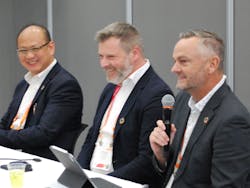Sustainability efforts delivering tangible benefits
Specific actions by industrial companies to become more sustainable have grown exponentially over the past decade. Yet there is often more talk than action around industrial sustainability.
To show how Rockwell Automation’s partners and customers are making industry more sustainable, Rockwell invited three companies to share their insights about the sustainable services and technologies they offer and how they are being used to change industry.
Those companies were:
• Energy Drive, which uses variable frequency drives (VFDs) to reduce industrial energy use, thereby reducing carbon emissions;
• LanzaTech, a carbon recycling company that transforms carbon dioxide emissions into ethanol for re-use; and,
• Triple Helix, which recycles end-of-life chemicals and materials for re-use by industry.
James Hynd, CEO of Energy Drive, explained how the company uses core automation devices—such as VFDs, controllers and human-machine interfaces (HMIs)—and applies its own data analysis to the data derived from these technologies. We optimize motor use to produce carbon offsets through OpEx and CapEx avoidance, Hynd said. Energy Drive can scale its approach over hundreds of systems at a company through its focus on motors, which are used widely to power pumps, fans and various pieces of equipment.
Referencing an Energy Drive project with Sibanye-Stillwater gold mining in South Africa, Hynd said they focused on the motors that power the circulation vents, which are critical to providing air to underground mining operations. The vent fans’ baseline energy use of 1720.3 kW has now been reduced to 605.75 kW.
Scott Kongkitisupchai, technology advancement director at LanzaTech, noted how the company, whose large-scale plants can process 50,000 tons of ethanol a year, depends on core automation technologies to control motor energy use and monitor vibrations on compressors and pumps to predict equipment health. LanzaTech recently announced a collaboration with Dow Chemical around the use of LanzaTech’s CarbonSmart technology to develop Dow’s EcoSense 2470—a recycled carbon-based surfactant for home cleaning uses.
“Most discarded polyurethane products—such as mattresses, furniture and car seats—are incinerated,” said Steve Peleman, CEO of Triple Helix. “In Europe alone, the amount of mattresses disposed of each year, if stacked, would be 800 times the height of Mount Everest.” Triple Helix’s Antwerp, Belgium, facility recycles polyethylene terephthalate (PET) and polyurethane foam (flexible and rigid) with a typical output of 30 kilotons a year but is designed to run as high as 80 kilotons.
The real sustainability challenge
Though achieving significant sustainability goals can seem like an insurmountable challenge using available technologies, the three companies participating in this roundtable discussion stressed that the technologies needed to deliver appreciable sustainability gains are not just available, but widely in use by industry today. The biggest roadblocks to sustainability tend to be attitudes and culture around funding.
“It’s sexy to talk about sustainability and the circular economy, but less so when you try to get people to do something,” said Peleman. “A key factor is getting rules to change around funding mechanisms for sustainability, because you can’t just throw everything into a pile and see what works. It costs significant money to organize waste sources for reuse. For example, in Europe it costs 65-70 million euros to start up a materials recycling operation.”
Hynd added that while it’s not difficult to change mindsets about the capabilities of the underlying technologies, it can be difficult to convince them of substantial sustainability results. “When we develop a technical proposal, we get 45% average savings,” he said. “But most companies think that’s too good to be true.”
For those companies that don’t believe Energy Drive’s numbers, Hynd said they can potentially send them a report each month detailing the carbon offsets they’ve lost out on that month by not using Energy Drive’s service. It’s not a standard practice, Hynd said, but well within their capabilities.
Technology wishes
Despite the lack of issues with current technologies, the roundtable participants noted a few technological capabilities that are on their wish lists.
Kongkitisupchai said LanzaTech’s converting operations need to close the sustainability loop with suppliers’ materials from which they derive ethanol. To better enable this, he said higher levels of security for data sharing between companies along with artificial intelligence applications to improve predictions based on those data would be helpful.
When you’re converting waste to raw materials, you have to know what’s inside them, said Peleman. A real-time view at the molecular level of what’s in there without having to go to a lab would fill a technology gap for Triple Helix.
“Supply chain lead times are still a challenge,” said Hynd—a fact that underscores Rockwell Automation’s focus on supply chain planning with its Plex software as a service. Despite this gap, Hynd added that sustainability’s technology problem isn’t with any specific capability or lack thereof, but because “there’s so much out there—it’s almost too much. With all the technology now available, companies can be tempted to reinvent too much and lose focus. They key is to focus on controlled innovation with help from partners.”
About the Author
David Greenfield
Automation World
David Greenfield joined Automation World in June 2011. Bringing a wealth of industry knowledge and media experience to his position, David’s contributions can be found in AW’s print and online editions and custom projects. Earlier in his career, David was Editorial Director of Design News at UBM Electronics, and prior to joining UBM, he was Editorial Director of Control Engineering at Reed Business Information, where he also worked on Manufacturing Business Technology as Publisher.

Leaders relevant to this article:

